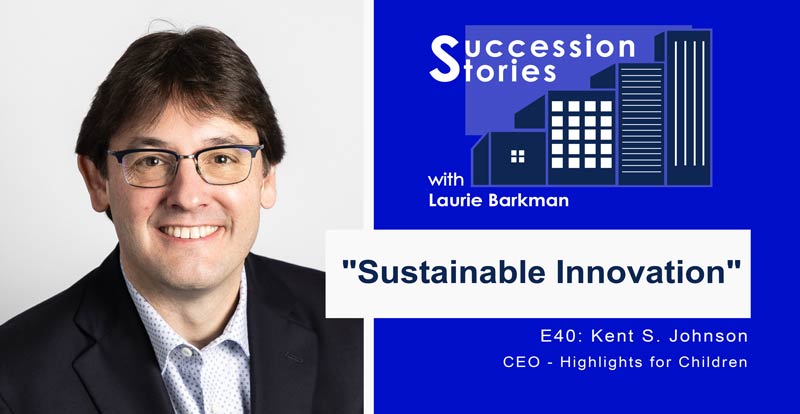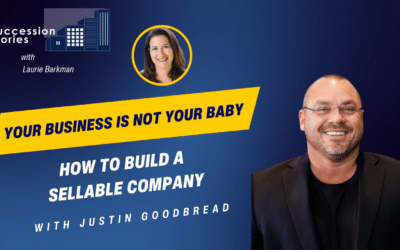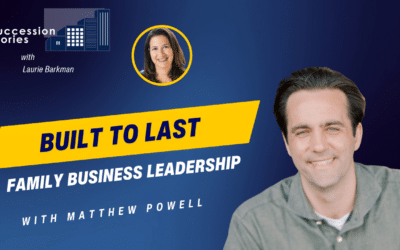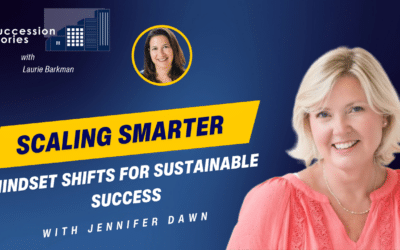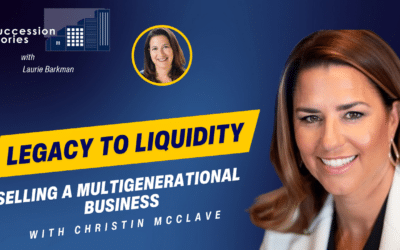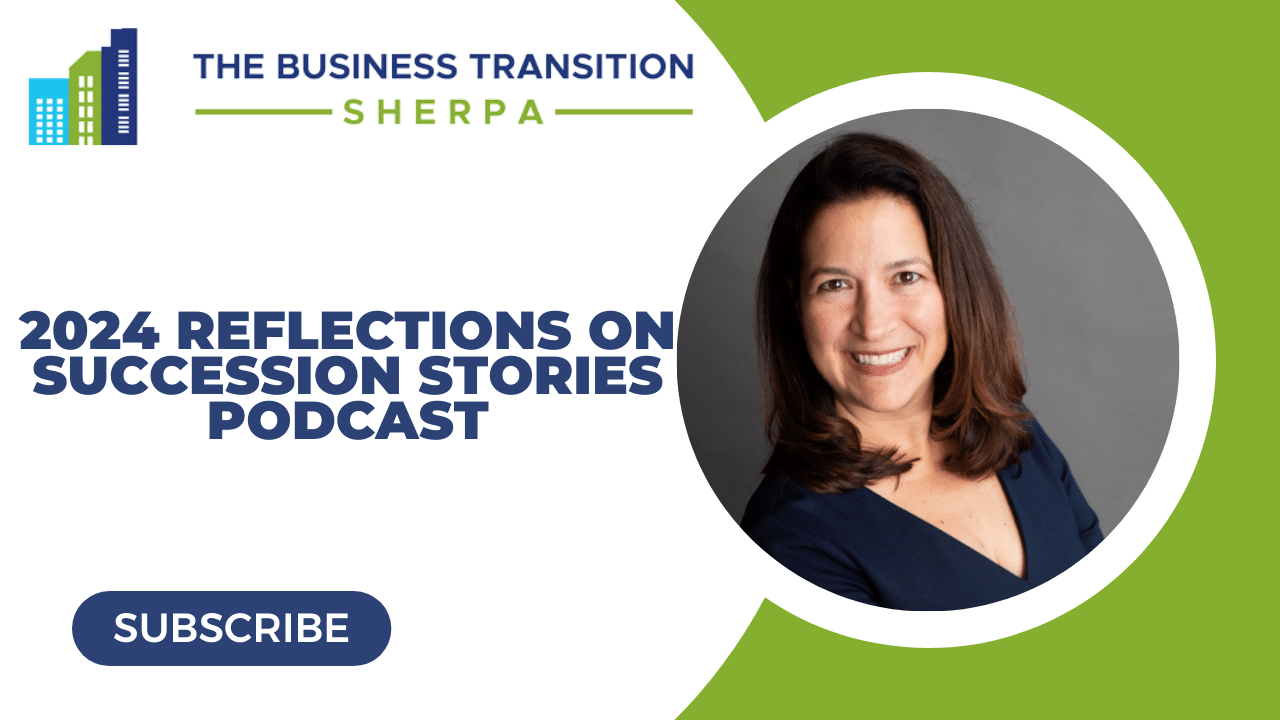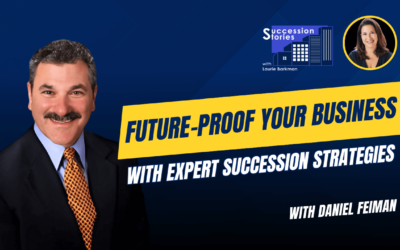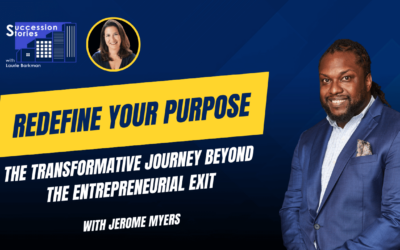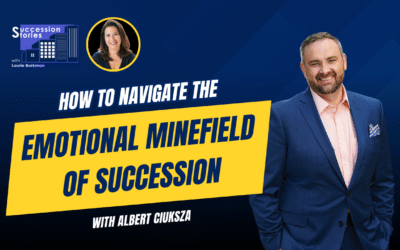Listen to the episode
On this episode of Succession Stories, Laurie Barkman is joined by Kent Johnson, the fourth-generation CEO of Highlights, best known for its children’s magazine. Listen in as they explore how Highlights’ mission and values foster a culture of empathy, innovation, and customer focus that has strengthened their resolve throughout the pandemic and for generations to come.
Listen in to learn more about:
- Resilience through unexpected transitions
- Governance and succession in a family business
- Customer focused innovation
- Mission driven leadership that transcends generations
Show Links
Kent’s LinkedIn
https://www.linkedin.com/in/kentjohnsonhighlights
Highlights website
Transcript:
Welcome to Succession Stories insights for next-generation entrepreneurs. I’m Laurie Barkman. I’ve spent my career bringing an entrepreneurial approach to mature companies struggling with change. As an outside executive of a third-generation 120-year-old company, I was part of a long-term succession plan. Now I work with entrepreneurs privately held companies and family businesses to develop innovations that create enterprise value in transition plans to achieve their long-term goals.
On this podcast, listen in while I talk with entrepreneurs who are driving innovation and culture change, I speak with owners who successfully transition their company and others who experienced disappointment along the way. Guests also include experts in multi-generational businesses and entrepreneurship. If you are a next-generation entrepreneur, looking for inspiration to grow and thrive, or an owner who can’t figure out the best way to transition their closely held company, this podcast is for you.
Subscribe to our newsletter for more resources to build value in your business, visit smalldotbig.com and sign up today.
Laurie Barkman:
On today’s episode, I was joined by Kent Johnson, the fourth-generation CEO of Highlights. There are some products that evoke fun memories from my childhood, and Highlights for Kids is definitely one of them. Maybe you remember the hidden picture puzzles and brain teasers and seeing the magazine in your dentist’s office? Highlights’ Founders were in their 60s when they launched the magazine with a mission to enhance childhood education. Kent shared the company’s unexpected succession stories including his own. We talked about how Highlights’ mission and values foster a culture of empathy, innovation, and customer focus that has strengthened their resolve throughout the pandemic and for generations to come.
Laurie Barkman:
Kent Johnson, welcome to Succession Stories. It is so cool to talk to someone that brings back nostalgia from my childhood in your company. Highlights does that for me. When you and I talked the very first time I told you about how when I would go to the dentist’s office, I would really look forward — which is kind of crazy, to look forward to going to the dentist — but the magazine was one of my very favorite things there in addition to the little prizes I got after my visit. There are so many people that might be listening that have that same nostalgia. That being said, there are some really cool things to talk about with your company and what I like about your story, your succession story, is that it hits on all three pillars of this show, which is innovation, transition, and growth. So Kent, welcome. Why don’t we start by you telling us about the history of Highlights and connecting us to key people in the first three generations of the company?
Kent Johnson:
Certainly. First, Laurie, it’s great to be here, and I never grow old of hearing stories of how our products and our brand has had a positive impact on people. I mean, that’s really why we do what we do and we have been around a long time. Well, every adult that I speak to has at least had the chance to have experienced it as a child. We were started in 1946 by my great grandparents, and really they were not your classic entrepreneurs. They were 59 and 61 years old when they started the company.
Laurie Barkman:
Wow.
Kent Johnson:
Their thought was to pour their entire life’s experience: they were lifelong educators, wrote a lot on parenting, spoke a lot, we’re in a parenting movement in the 20s, 30s, 40s and they wanted to pour all that experience and really their philosophy about child development and healthy family relationships into a product that could directly reach kids and families at home.
So they started the company, threw their life savings into it, and it was a slow start. I mean, magazines weren’t a huge category for kids. So it was early going, it was tough. I mean, they were about product. So there were business challenges. There were ups and downs, those early years.
In fact, I think we really became a family business when their children got together to decide who was going to go help them understand it was time to shut down their dream. So their son Garry Meyers, Jr. took a leave of absence, he was a helicopter aeronautical engineer, took a leave of absence to come convince his parents they had to give this up. What eventually happened is I think he was brought into their spirit to their mission and had an entrepreneurial insight that “Maybe we could make this go.” He could make it go so he and his wife eventually joined the company, relocated their family to Columbus, Ohio, and raised a little money, got some investors, got the company out of trouble, and were able to really turn it around, and they started things like the program you described – putting sample copies in doctors’ and dentists’ office waiting rooms. They also started a really important program, working with teachers. To show teachers the product, to try to get them to recommend it to parents. Those two things really turned around, saved the company as they built the team and grew the business. So that was the kind of early history of the company.
Laurie Barkman:
That’s a really interesting fact that the founders were basically 60 years old when they launched the business. There’s a lot of people now thinking about transitions and starting a business. But this is probably a very rare example, even back then, to be in that age bracket and being entrepreneurs. What do you know about that time horizon from when their son Garry sat down with them and said, “Hey, you need to shut it down.” Was the company, Highlights, around for five years or longer or shorter?
Kent Johnson:
I think it was in the late 40s. So I think the innovation that he and his wife led with the management team was in the mid-50s. It was an incredible time to be starting a company, but this is just after World War II. So we had paper rationing. The founders, essentially, as a company — just a side note — the founders had already committed to a family home for their retirement. So they started the editorial group to make the product in northeast Pennsylvania in a town called Honesdale. But you had to have a presence to work with your door-to-door sales team and your printers in 1946. So we opened a business office here in Columbus. So we’ve been working remote, and not just in the pandemic, but in a way, we’ve been working remote since 1946. I do also think in 1946, I think there’s some wonderful stories, they really were a husband and wife team, my great grandmother was way ahead, I think in some ways of doing things that maybe women were less encouraged to do at that time. So she really was an important business role, and the company wouldn’t have happened without her role.
Laurie Barkman:
So they pioneered and they were educators, and they were certainly mission driven. The second generation, which would be your grandparents, is that correct?
Kent Johnson:
Yeah, so my great uncle would have been Garry Jr. who came in. I think there was general support. My grandmother was their daughter and they had another son, who became the science editor, Jack Myers, who was a professor down at the University of Texas but got very involved. I think, collectively, everyone was proud they had a Ph.D. scientist as their science editor for young children, and I think we continue that tradition today to try to have the best of science really represented and explained in a rigorous manner to kids.
So there was an involvement, unfortunately — and just to play out a little bit, the history — the two siblings who were less involved day-to-day did get more involved, unfortunately, as a result of a tragedy that hit the company. So in having had this rocky start, being on the verge of failing, things had really turned around in the 50s. And in fact, in the summer of 1960, we built from the ground up with company cash, no debt, built company headquarters. Family businesses don’t like debt, right? So we got to the point we can build a building. We have a great photo of the day, they dedicated that.
And in the summer of 1960, things were really looking good. The circulation of the magazine was up to half a million. And then in December of that year, some executives including Garry Jr, and his wife, Mary, were going to New York for a business meeting to look at putting Highlights on the newsstand, believe it or not. And tragically, there was a mid-air collision over New York City or two planes collided in a winter storm, everyone on those planes horribly perished. And you had a situation for many companies because business travel was really what was going on at that time. So you had a terrible situation for many companies and families. But our company faced a situation where three of our top executives were lost, and the founders lost their son, their daughter-in-law. So it really threw our business, family ecosystem into crisis.
I still today, I wasn’t alive when that happened in 1960, but I still draw strength from the stories I’ve heard of how the commitment to mission, the commitment to what they were doing, they leaned into that and said, “Okay, we’ve got to rebuild.” You can hardly imagine how at that point you have founders in their 70s. You have my grandmother and great uncle kind of leaning in and saying, “Okay, now we have to get a little more involved in the board.” There was a surviving executive Dick Bell, who was already in New York. He ably led the company, he rebuilt the team, he was committed to the mission. So they really had to go through a process; a completely unplanned and tragic succession, go through a process to rebuild the sustainability of the company and the family had to of course, go through the process of incredible grief and dealing with that reality. So it’s hard to imagine. But for me today, as we face challenges or as this pandemic hit our society, I reflect that — and I think all companies can reflect — if you’ve been around, you’ve gotten through things in the past. Right? So how do you draw strength? Particularly when you’re a family business, when you’re a mission-driven company? How do you rely on that to give you perseverance?
Laurie Barkman:
I can’t even imagine the loss, the feeling of loss that everybody had felt not only as a family, but also the employees. I’m guessing based on what I know of your company from talking to you originally and looking at information online, and it’s probably a very family-oriented type of culture so I’m guessing the employees felt as much tied to the grief as the actual family members did.
Kent Johnson:
I think that’s true, and I can’t imagine it. But what I’ve seen, we’re not a company that has big factories, we’re a company that talks all the time about what we’re about. I think one of my major focuses is always about employee engagement. So when we’re at our best selves, it’s because we’re committed to what we’re doing together so there’s a real community feeling we try to create. I mean, there are so many stories of how in the early days how employees came together on the back porch of the founders. So when your board room is a screened-in porch in a beautiful farmhouse setting, I think it creates a little bit of a different culture. And so I think it was just a horrible felt throughout the company. I just consider myself and our current employees so lucky, and grateful that they did find a way to persevere.
Laurie Barkman:
Absolutely. So third generation CEO, was that a family member? Or did the company hire someone from the outside?
Kent Johnson:
We did have a third-generation CEO as a family member. I can’t remember the exact dates but Dick Bell, who was an educator by training and a business person really led the company for a long period of time. One of the things he did is he diversified the company, helped us acquire, outside of Highlights the consumer brand, helped us acquire companies in the education space. A curriculum company called Zaner-Bloser we acquired and still operate and run today does incredible things for foundational literacy skills in elementary school. He then also mentored the son of Garry Jr. — Garry Meyers the third, who was my predecessor — mentored him, and he eventually took over as CEO, I think, in 1978-1980, somewhere in that range. He served as CEO; Garry Jr. served as CEO for about 26 years until I took over. And his cousin Kent Brown, came in over time, and was mentored by Caroline Myers, and became the editor in chief; really became responsible for the product. So you had two cousins on the business and on the editorial side in the third generation
Laurie Barkman:
Great. Well, it sounds like the company really had a period of growth, and it’s growing organically but then it also added in some other companies to really take it to the next level and diversify. So let’s switch gears and talk about your story. What’s your background? Where did you grow up? Then take us through your education and how you eventually came into Highlights.
Kent Johnson:
It’s not the most linear path. I’d like to say I did everything I could to not join the family business and somehow failed at it, but it’s interesting. As a family, we do a lot of work and have great family business consultants on governance on education. Our focus is really on stewardship. Even though I never had a parent who worked for the company I never lived in a city where the company had employees, I grew up in a family culture, trying to encourage stewardship of the company and the mission and the dream of the founders, so we’d visit and that sort of thing. I grew up in Schenectady, New York, and I probably had some, I certainly had some desire to be an educator.
This is a family of educators. We have many more helpers, doctors, educators, social workers than we have MBAs in our family, so I wanted to be an educator, but then got bitten by a love of science in general, but also particularly physics. I ended up going to college and studying physics. I took a brief break and went into the classroom and taught high school physics, trying to figure out do I want to be in the classroom do I want to be an educator, but I couldn’t resist the physics bug. So I did go back and earn a Ph.D., spent six long but enjoyable years in a basement lab to earn a Ph.D. in physics.
Not the typical preparation for children’s publishing, for sure but what happened is I realized, along the way, I didn’t really want an academic career in science. I wanted to do things that I hoped would have more impact on people and society. After physics, I actually only really considered jobs that brought me into a research role that had a medical or health component. I went to a small startup where I worked on medical diagnostics; instruments to do measurements to help drug companies develop new drugs, that type of thing, where I really could see a through-line between what I was doing and a societal benefit.
I also love the complexity and the collaboration and the innovation that happens when you bring people together of different disciplines so the ability to be trained in physics, but work with engineers and biologists and software people and chemists, material sciences was just an incredibly exciting place to work and we did great things.
But that change was a huge change from working in a physics lab and I loved it. I loved the business aspects, the complexity of it, the organizational aspects. What happened when I was in biotech is I started in the lab bench and over about six years really moved with our product and our technology into the market. Got to work with customers, got to worry about field support, manufacturing, how we make the things we’re going to sell.
In that time, our family had a program at that point to bring people at the right age into a rotating role on the board of directors to see how the company really worked, so I said, “Wow, this company is a little more interesting than I realized, it’s not a little magazine, we have a diversified company, we’ve got these incredibly talented executives, we’ve got all these different business models.”
I realized we faced some tough challenges. That was in the early 2000s; “How is technology going to change publishing? How’s it going to change? What happens in the classroom? How are these business models evolving?” I realized at that point, it was a much more interesting company than I had ever thought and near the end of that board stint my predecessor, Garry Myers III, he said to me, looked at me as sort of a funny side smirk and said, “You’ve always told us you wouldn’t talk to us about working here, because you’re a science guy and we’re not a science company.” And he said, I’ve been listening to you talk about your work and you actually are no longer a science guy. You’re a business guy.”
He basically said, “Look, either own up to it, that you’re a business guy, and you don’t want to work here, or, maybe we can have a conversation.” I paused because he was right. I had become a business guy. I really was very interested in all of the complex issues of ‘how do you actually serve customers?’ and that probably started a year-long conversation then I did what you’re not supposed to do.
Laurie Barkman:
What was that?
Kent Johnson:
I think we were really on the verge of saying, “Okay, here’s a specific role at the company that maybe makes sense,” and I was on the verge of discussion. We were expecting our first child, so in those discussions, I decided, “Okay, this is a reasonable transition to make,” but had to stay in suburban Washington, DC until our son was born. You can’t move in the middle of that with the support network you have. So did the career transition that involved being a first-time parent moving to a new city where you don’t know anyone and completely changing industries. So a fair amount of stress. No one would advise you to make that much change in your life but we did and then, on the other hand, what it did give me was a four-month hiatus from work to really be a first time parent in partnership with my wife, so there were a lot of benefits, but it was a kind of a crazy way to do things.
Laurie Barkman:
I love a few things you mentioned there. One is that the Board of Directors had the forethought to let younger people, the next generation, into the boardroom. That’s a pretty unique situation, isn’t it? I haven’t heard of that before.
Kent Johnson:
I think it is unique, and it’s been a program that’s existed for a long time, and it’s gone through evolution. So we still have a program. That’s the sort of successor program which we call now a board fellowship, where we give some exposure but also have a very structured way that next generation can really learn about the board and the governance, meet independent directors — we have an entire board dominated by independent directors — and also learn about the company meet the executive. It’s a very structured education-focused, intensive educational program.
I have to give my predecessor credit because there was a period of time, and I don’t remember exactly when I started, but they realized that in our third generation, which is 13 descendants, that there was a situation or an evolution of reality. That there was a certain group that was involved in the company, they were their employees, or directors and then there was a group that wasn’t directly involved. They realized that that would be unhealthy if they didn’t have a mechanism to make sure everyone was connected so they really started it in the third generation, to bring those who weren’t in the company and put them in the boardroom so they really could understand what was going on.
They went through everyone twice, actually, and then in my generation, it was “How do we educate? How are we going to do succession of this mission and have good governance practices to the next generation?” My generation has 27 so it’s a bigger task, but they went through all of us, or I guess we’re still may be going through some but it’s evolved. I’m grateful to our independent directors who take it very seriously, invest time and, invested time in talking to me and helping me understand back in the 2000s, but continue to do that. I think as a CEO, now, my primary focus is making sure we have an effective and efficient board and so you have to balance the work of the board, good governance of the company, particularly since we’re facing so much disruption, with the family stewardship and education. But if you work at it, you can balance those two things.
Laurie Barkman:
Do you have a separate family council in addition to this independent board?
Kent Johnson:
We do and we have interfaces and we’ve benefited from multiple instances of great family business consultants. I’ve tried to follow best practices, so we have a family council, a family assembly, governance processes – they’re sort of formal ways of how the interaction happens. But we think it’s incredibly important for our independent directors to have a direct feeling of the family and its commitment to the company. We also think it’s really important for all the family members to feel like they understand and see how the governance of the company works.
Laurie Barkman:
So the role of the independent board, I guess, if you had to boil it down, I’m hearing two themes, for sure. One is governance and the other is strategy and succession. Because their mission is to help you and the family in thinking forward about how to take the business to the next level, because this is a company that everybody’s interested in seeing succeed for generations to come. Any other roles that the board plays for you and the company?
Kent Johnson:
I think you’ve captured it. We’ve been through — and we haven’t talked about how I became CEO but we’ll get to that — we’ve been through succession, I think it’s always, particularly in a family business our family has a mission statement that talks about wanting to own the company forever and we really believe that being private allows us to operate in a way that takes a long term view of the benefit we’re creating for all our stakeholders, and most importantly, the children we serve, but also our employees, our partners, our vendors and our shareholders.
We kind of believe in this idea of stakeholder capitalism and think that being a private company sort of does insulate and allow that culture and that focus to continue. That being said, the board’s always got to worry about succession. It’s a very supportive board, very strategic, I think. I’m always looking for them as how can they add value to the company? How can they make me a better leader? How can they make our team better? How can they help us with organizational talent issues, as well as keeping us focused and disciplined to be thinking about what’s happening in the world? How’s the world changing? I think the number one thing we’re focused on is how do you change and adapt because the world is not slowing down? It’s speeding up and if you’re serious when we were about to celebrate our 75th anniversary as a company, and if you take the idea seriously, you want to be here for another 75, I think you need the absolute best strategic oversight and adaptability you can get.
Laurie Barkman:
Yeah, absolutely. Well, let’s go back a little bit on your transition. You had the baby and your wife and yourself. You moved to Columbus, Ohio from DC, and you started to raise your family there and now you’re CEO, what happened?
Kent Johnson:
Well, I came in actually to a role in strategic planning. Actually while I was sitting on the board, I was watching the board pressure my predecessor about his succession plan. His health hadn’t been perfect. He’d had some cancer along the way. In fact, I think at the time I came in, we’ve talked about how he’d really stolen yours, he probably shouldn’t have survived. He had a very fortunate experimental treatment. So when I came in, he was probably 59. So we plotted a three to five year transition, let’s see if this works out, nothing’s guaranteed. You’ve got to be mentored, let’s see some development. We were working that process and his health started to get worse, so we’re starting to accelerate it. He looked at me and said, “Well, it seems like you’ve convinced people you work hard, and maybe we can give you a little more responsibility sooner.” We were even talking about evolving job descriptions and a transition and unfortunately, in January of 2005, he died suddenly of a heart attack. What’s interesting, and I still think somebody who’s been through such serious medical issues, I think he had a sense of things and our independent direction at that time had been saying, I think they’d said to him, “You’re accelerating your plans for succession and we’re concerned, you haven’t communicated it to the family to the shareholders.” He actually — I mean, it’s almost eerie to think about it — 15 years ago, but he took a bunch of excerpts from the emails he sent the, the independent directors about the succession and how he felt about it and he actually sent them out to the entire family the night before he died.
Laurie Barkman:
Oh, my goodness.
Kent Johnson:
I was very close to him, and still think of how he approached problems. Of course, even it seems like, it just is hard to believe it’s been so long but there’s the situation we faced. I’d been in the company at that point, take the two years of board so I had some background and some comfort with the board, but I’d only been working as a day in day out employee for six months when he passed away. I was 36 in a new industry. I joked to my board after five, six years once we were there. I said, “How could you guys have put me in such a stressful situation? What a crazy thing to do.” This is not a good succession story. Like, you don’t want this succession story but I think the independent directors is interesting. What we did is we paused. We said, “Hey, we’ve got these great three independent directors who know the company who know the people,” and we kind of paused succession on the board, we asked them to extend their terms. We said, “Will you see this through, this transition? Let’s have stability at the board when we have transitioned the CEO level.”
I remember pretty vividly, the board sort of said to me, “You have one job tomorrow. Don’t break anything,” and they said, “We’re not gonna have any 100-day plan, things are fine,” then they more seriously said, “Look, you actually have two jobs. You’re gonna figure out how to be CEO. And you still need to be learning these industries, learning the people, learning the organization.”
So I had a lot of support and no pressure for rapid change. I think we were really fortunate at that time the company was in a good place. We had great leaders, we had stability, so it allowed the time. But I still look back and as we brought on a new president this year for our consumer business, we talked about what’s the 90-day plan, and said, “You know what, our plan here is to take enough time, so you really can learn the people and the business.” So I think there’s a go slow. You can be successful or go slow. So you can go fast, kind of approach, which I think in organizations, sometimes people move too quickly.
Laurie Barkman:
There are so many important things in what you just shared. Another tragedy, another another loss and the company setting a course for succession. But of course, it got accelerated and that’s life, right? We try to plan for things but sometimes things happen out of our control. But there was foresight, and there was planning and too many times we hear stories where there was no backup, and there was no plan. So at least you were already kind of well underway. You lost a great mentor, obviously. But it’s nice to hear that you’ve had a lot of support and people rallied around you. You were a family member, you had spent time with the board and so when you were coming in you got the keys, so to speak, but you left the car in the parking lot. That sounds like the right thing, because it was just not the right time to make any changes. You had still a lot to learn, which is really important.
Kent Johnson:
It would have been incredibly difficult to bring somebody in as a bridge at that point. I think we had a lot of luck that it worked out this way. I think it’s always dangerous as a CEO to assume it was just your skill or it was destined to work. I think I feel very fortunate that things worked. But it was pretty stressful. It’s a pretty stressful period. I don’t think you want to do it that way.
Laurie Barkman:
Yeah. As you said, it was not the textbook way to have it go. But not too many times does it go in a way that we predict and being resilient, being able to modify and ‘adapt’ is a word that you used earlier. So the business, you mentioned that in 2005, when you came in was relatively healthy financially, which is great. Did that afford you over time, maybe not in year one, but starting in year two, or so on as CEO for you to take that look at disruption, what was happening in the market and looking at innovation? Because I love to talk about innovation. It’s evident for me as a child seeing Highlights, and now going to your website, and seeing all the amazing products that you have available for kids in a digital world. So over the past 15 years, and many other publishers have experienced this, too, it’s not just your company, but you’ve faced this growing shift and potential disruption. Your company seems to have done a really good job at positioning itself. How did you do that? What was your approach to understand those market dynamics? How did you skate to where the puck was going?
Kent Johnson:
Well, we make a lot of mistakes. As I think about it, there’s just so many false starts and innovation, and you have to be, I think we had to get better at stopping things that weren’t working. So there was a period of my career that was about stopping certain areas of business. But I think a lot of what I’ve learned about innovation has been about culture, and what’s your self-image? How do you think about yourselves?
One of the things that I think maybe frustrated me initially, or I had to think about how to evolve is how do you accelerate the pace of experimentation? Because I think there’s something that’s so good about publishing the deliberate kind of creation of very carefully vetted content that is connected to a certain slowness. So there, there was an evolution to try to how do we do things more rapidly as a company? I think that we’re always working on it because you have to go faster, you have to be able to stop things more quickly, start things more quickly and there’s no secret. I think you just have to always be working on that and obviously, there’s lots of secrets but there’s no one silver bullet.
On the other hand, I think the other piece that for me, it has to drive innovation, because I don’t focus on what are we doing in digital, or what are we doing in print, but having to evolve my thinking from us being a product company, like what products are we going to innovate, and try to say, “How are we going to put the customer at the center?”
So I love technology, like I’m a physics guy, I love toys, I love devices and I care so little about the bells and whistles of the technology in the context of the company. You have to focus on what I kind of try to preach internally; it’s about the kid, it’s about the family, and what does that technology do. So there’s a lot of things we’ve been very slow on in technology because we don’t see that it actually benefits kids. But when we have done things in technology, I think it’s been motivated by that breakthrough innovation to serve kids and families. That, I think, has led some of our activities to be more successful than if we just jumped in because it was cool or it was a way to innovate.
I also think it takes time. You have to suppress fear. Fear is the great killer of creativity and I think trying to get to where you can simultaneously be good at something you’re already good at, but not be afraid to get into the areas that are threatening to what you do and I think you have to have an optimistic point of view. So one of the things we talked about is how digital distribution is going to disrupt our existing business. You can spend a lot of time worrying about that. But what I see and what’s so exciting, and actually you probably can’t even see on our website, what to me is the most exciting digital stuff we’re doing because it’s all outside the US. Like the ability to reach children around the world with this incredible content that we’ve developed. Authentic content we developed in the US is being used around the world for practice for English language learners. So reaching kids in China, in Hong Kong, in Turkey, scaffolding their reading development and sort of working on the aspect of “How do you have a child love, learn to love reading, not just learn to read?” You can only do that through technology. A company our size, we’re a small, less than 500 people here in Columbus, Ohio and we’ve got 1000s and 1000s of kids around the world reading the content we made in a small town in northeast Pennsylvania. It’s pretty amazing that that’s possible. But it came from the mission of serving kids and thinking about what they need, not just thinking about technology and code and platforms. So I think if innovation is driven by a customer need, it’s far more likely to be successful. So every hire we make, I’m looking for customer obsessiveness. Like, I went on a little rant there.
Laurie Barkman:
In fact, I spend a lot of time with startups, I’ve worked in startups, I teach a class at Carnegie Mellon called the Corporate Startup Lab, which is about innovation and large companies and so companies can buy innovation through partnerships, or you can acquire an innovative technology or you can create it in house. So my experience is the create in house side, and I’m always fascinated by that, especially when there’s a multi-generational company like yours, you’re in the fourth generation, you’re about to celebrate your 75th birthday, as a company, and here we are talking about a startup mindset and agility and adaptability, and skating to where the puck is going so you’re not disrupted and at the same time serving your mission for kids. That’s what it’s all about. That’s what I find so fascinating about your story.
I think too, you could have a panel of kids telling you what they think about your product, but that’s only part of it, right? You’re looking out to the needs from an academic standpoint, education standpoint, and then your looks like you’re kind of marrying the two, you certainly want the usability side, right where you want your website to be – kids can use it without an adult’s help. So there’s that side of it, where they have to be very customer-oriented. But the other side is really the business side too because you want to be able to scale and be profitable. For example, one of the things I noticed on your site is created, you have a subscription box. Yeah, which I thought was really smart from a recurring revenue standpoint. So you have the products that you’re selling, which are scaling around the world, obviously translated, and that takes expense and overhead. However, when you can get that wonderful impact, where you’re able to really leverage the investments you’ve made, it’s a great position to be in as a company. And then the subscription box is probably just another example that I just happened to see. But maybe you have some others that you can share.
Kent Johnson:
Yeah, let me tell you my most favorite innovation example, because we all love technology, we think of technology as innovation. But actually one of the things I’m most proud of is an innovation we made in 2011, we launched a magazine for babies.
Laurie Barkman:
Babies!
Kent Johnson:
Babies!
Laurie Barkman:
Wow!
Kent Johnson:
Infant toddlers, zero to two-year-olds, think a nine-month old to a 15-month-old. This is one where we asked our editorial group to look at what are the characteristics of a magazine for babies? Because you think, “Okay, we know about board books, there’s examples out there,” so you think, “How can you possibly innovate?” They spent some time thinking, they came back and they said, “We want to make a magazine that is printed on plastic, printed on Tyvek and its hand-stitched die cuts on the edges are curved. Okay, well, they’re gonna put it in their mouth, it can’t have sharp edges, we can’t have staples, because we can’t have babies bleeding.”
Infant toddlers, zero to two-year-olds, think a nine-month old to a 15-month-old. This is one where we asked our editorial group to look at what are the characteristics of a magazine for babies? Because you think, “Okay, we know about board books, there’s examples out there,” so you think, “How can you possibly innovate?” They spent some time thinking, they came back and they said, “We want to make a magazine that is printed on plastic, printed on Tyvek and its hand-stitched die cuts on the edges are curved. Okay, well, they’re gonna put it in their mouth, it can’t have sharp edges, we can’t have staples, because we can’t have babies bleeding.”
“So it’s got to be stitched with thread. And we’re gonna make it plastic. Because well at home, we want the kid to be able to read and experience print in the bathtub. Or we want it to survive the constant licking and gumming or in a daycare center. We want those things to go on a dishwasher, so you can sterilize things.” So you say, “This is crazy. How are we going to do that?” And we currently have, I think, maybe 150,000-200,000 subscribers to Highlights? We’ve got large numbers of them that have been probably placed in childcare settings through partners, sold to institutions, early headstart, that type of thing. And you sort of look at it, you’re like it’s not as sexy as an app or a platform that can reach everyone in the world. No, but like, as an example of consumer end user-focused innovation, and doing something that you would never really think to create a plastic monthly magazine and figure out how to ship it, how to make sure when it gets there, it’s inside something because you can’t have whatever’s in the postal system in your child’s mouth. So it’s got to be shipped in an entirely different way. But also for us, it was also a mission. So why would we do that? And we got really passionate and it’s still our that what happens in the brain from age zero to age three is so critical to human development. And we realized as a company, we did not want to be a two to 12 company. We wanted to be a birthed-on company. And from that submission perspective, we wanted to make an impact in those families as early as possible develop the bonding Between mom and baby, develop the pre-literacy behaviors. But also from a business perspective, we didn’t want to go head to head with Minecraft and Roblox. And so our focus had to be on how do you engage families earlier to make sure you have a long enough relationship for the lifetime value of the company. So if we can start working with families, when they have a six-month-old, we have a much better chance to be a successful company than if we wait until the child’s four or five.
Laurie Barkman:
That’s a really smart strategy, because as you said, you extended that lifetime value forward, pulled it forward. For me now my kids are older, but I definitely recall having little books and they put them in their mouth and it was in the bathtub and I was always finding need for things like that. Now, I’ve now discovered my newest bait, go-to baby gifts, this is going to be great, I’ll have to check that out for friends and family when they have their babies. That’s a great example because also of the niche aspect of it. Where you really got to understand parent need and what they were looking for as well as the daycare center and these other centers were an understanding the utility of that educational item in that setting. That’s just so important. So that’s a really, I think, a wonderful example, I’m not surprised that that’s one of your favorites.
Kent Johnson:
Well, I take no credit other than I’m so grateful to people we have that think so deeply about what happens in childhood and child development. Then you have to have a shout out. That the operations people have made it work at this scale still blows me away.
Laurie Barkman:
Yeah, that’s really cool. You mentioned the pandemic earlier, I want to spend some time on that. Because it’s about leadership. In your experience, when you reflect on the last year, what do you think about in terms of the impact of the pandemic on your business? Were there any major setbacks? And how did you get through those?
Kent Johnson:
For us, it’s a tale of multiple stories. So on the business side, first, we have companies that sell to schools, curriculum into classrooms, professional development services, resources that help teachers kind of develop the broad range of skills they have. We were in our prime selling season, spring, and everyone shut down the schools. So in a way, it was terrifying. Because you had to pivot in a day, the sales force from making sales calls to instead trying to enable the customers to better use the products they already had in adapting to virtual learning. Your whole revenue model is completely up in the air. So I’m so impressed how people adapted and always said, “Is it focused on the needs of the customer?” That’s how we’re gonna get through this week, next week, this month, and we’ll see what happens.
On the consumer side, we did see some — after some initial shock — we saw increased demand. And on that side, we have so many parents, or former parents, at different stages. We were all experiencing this disrupted society and we all tried to put on our empathy to the customer and say, what, what can we do to help? What would we need, if we were suddenly now a teacher at home? So that that group was really I think, able to lean in on home learning products and lean in on free content, that would be printable, not just I mean, everyone was gonna get plenty of screen time. That was pretty clear. Right? How do you give parents ideas to do things that are off-screen? Knowing that but we’re all in the midst of the same disruption? So I think the higher-level issue was fear, uncertainty or as leaders, how are we going to take care of our people? So how do we make sure people are safe when we don’t really understand all the science? Like how do we make sure we can function remotely where people are safe but can do their jobs? So I think I’m just so grateful because I think across our leadership team, what I saw is people stepping up, like rising to the occasion. We learned that we should and I think this is a lesson I hope we’ll never forget, you’ve got to trust your people trust, and empower your people. Like things people did things in the company without being, they didn’t require any top-down instruction. Just like okay, we’re going to work remotely. Let’s figure it out. So I think for me, it’s increased or reminded me how important humility is for leaders for empathy. And then things I think evolved like we’ve tried to stay incredibly attentive to the social-emotional needs of our company to the communication to how do you maintain social engagement and I think we’ve come up with ideas and sort of modes of communication that I’m sure will persist long past this. And I kicked myself as we could have been doing all company video calls, we could have done it 10 years ago.
Laurie Barkman:
Exactly. It’s amazing how all of us I do Zoom calls now with family for we’ve over the last year, we’ve done major holidays over Zoom, and my relatives live all over the country, we’re not in the same city. Why were we doing that before? It just never would have occurred to us and yeah, what would be an example of something that you’ve been doing as a culture engagement piece using technology with your teams?
Kent Johnson:
I think the number one is, it’s the frequency and the type of communication. So it’s getting everyone together every week, every one together with a mix of content and a mix of emotional connection type things. So I’m kind of an introvert by nature, but sometimes it’s a little bit like a talk show. We all have to talk about the emotions we had about having this holiday, we just went through where we couldn’t be with our family because we’re all going through this experience. And we need to connect on an emotional level.
But I think also it’s accelerated our sharing of information. So I’m a huge believer that if you’re the right person if you’re to be working at Highlights, you should get positive emotional energy and feedback from hearing about the good things we’re doing. So finding ways to share the ways different parts of the company are trying to serve customers, I think can raise our overall morale and increase engagement. So that’s a piece that, you know, we used to do that, you know, 15 years ago through like a newsletter, but to be able to do it through video and more frequently in bite-sized pieces is very effective. And I think also, it’s the interesting, interesting thing, we’ve, we’ve also learned, we have a lot of remote teams. So we’ve always had people on the speakers in the ceilings or joining meetings remotely. And one of the things we’ve observed in our teams that are in different locations when you’re on zoom, everybody’s kind of an equal. So we’ve learned some things about how meetings were; you had some people in the room and not in the room were less effective, because, you know, we didn’t have the technology, or it’s not just the technology, the meeting habits to make sure everyone was included. So I think we’ve found ways that are going to let our teams that aren’t all in the same place work better on into the future, even when we don’t have to because people have seen the possibility when we really all are connected and can all kind of participate in the same way. Even though it had to happen through this pandemic. I think we’ve learned some lessons that we’re going to figure out how to persist.
Laurie Barkman:
That’s really cool, and you’re totally right, I’m kind of chuckling about my experiences in companies where we had a room of 15 people, then we’d have one or two on a phone and it just didn’t work. The vibe certainly wasn’t there. It’s a great thing that you’re doing to recognize that there’s a lot of value in how you can move those new traditions forward. So on that note, though, I want to talk about legacy as kind of rounding down this discussion today. Because you’re the fourth generation and you talked about the next generation approach when you were coming into the company. Do you think that there’s interest from generation five, who I don’t know what age group, they might be for all your cousins? Is there any interest you think, to having people come in? And then also, what is most important to you as part of your leadership legacy in the company?
Kent Johnson:
I mean, this is a multi-part and complex question. I think it’s a very dangerous thing in our very fast-paced, very competitive world to assume or even hope that the DNA pool of one group will produce the right, the timing, and the training, and the right leadership match for a company of our size. So our focus in succession within the family is about engagement with the mission of the company, it’s about promoting group stewardship for good governance and for the mission and dream of the founders. So we don’t presume. Maybe we have people who want to get involved in governance or as employees in the fifth generation, but what we really focus on is trying to have as many people as engaged as possible in stewardship. So in terms of the legacy, I would hope to have in the family, I just think of myself as I just want to transmit stewardship that I inherited. So I want to be seen as just one of the continuum. That would be the best legacy in terms of the company, I’ve been at this now, geez, 16 years, which, but I’m still relatively young. So I don’t really think a lot about legacy. One of the things I think a lot about which I would be very proud to have been my legacy is we’re trying to figure out how do you have the mission and the values associated with the company become a sort of irreversibly part of the culture. So I spend time thinking about how to make a culture for a company that doesn’t depend on individuals, that will be self-sustaining. So we’ve been through tragedies and I am very passionate about what we do. I talk to people inside and outside the company passionate about our mission. But I also recognize someday I won’t be able to do that. So how do we create a way that more and more people can be part of it and speak with passion and can sustain it? Because if we can build it into the culture, we can be invincible.
If it requires specific individuals, we’re always at risk. So we’ve got a lot of people thinking about that problem and working on that. We’ve created the role of Chief Purpose Officer. Our editor-in-chief, we promoted her into this role of Chief Purpose Officer which sounds a little corporate, but it was the best. It accurately describes what she’s doing and I talked to her and we talked about what she has to do to try to help us advance our purpose outside the company. So thought leadership partnerships, working on projects that people in the world will know about. But there’s also a really critical internal role, trying to create ways that we talk about and institutionalize our purpose internally, to try to create glue, bring as many employees as possible, educate them, engage them, talk to them about the purpose, and have it be living breathing throughout the company. I think I also want to be a Chief Purpose Officer, I think we all within a company. I want to have a company where every employee is part Chief Purpose Officer, but for now, we’ve put someone in that role that’s really trying to focus on institutionalizing what we’re about as an entity and if we can succeed at that I would be proud to have as a legacy. Because I think if we do that the business results will follow.
Laurie Barkman:
That’s awesome. That’s a really great philosophy, I think. And I’m not surprised, based on everything that you’ve said that you’ve emphasized that role and having someone focus on it. So that’s really, really cool. The last question for you, I’d love to ask all of my guests is if you have a favorite saying or mantra about entrepreneurship or leadership?
Kent Johnson:
If people ask me my favorite saying, our foundational belief as a company is children are the world’s most important people. So that’s usually my go-to favorite saying but that’s not exactly about entrepreneurship. But in a way, it is because I think if you think about some of the comments I made in the context of a company, innovation, and leadership has to be about the customers you serve.
Our ability to maintain focus on children has to be a part of all of our leadership has to be a part of the innovation we’re trying to achieve.
So our ability to maintain focus on children has to be a part of all of our leadership has to be a part of the innovation we’re trying to achieve. You’ve made me rethink it. It’s not just a mission and a belief, it has to be a kind of a north star, foundational concept for our leadership as well.
Laurie Barkman:
And if people want to connect with you online, Kent, what’s the best way for them to find you or to learn more about Highlights?
Kent Johnson:
Yeah, I’ve tried to occasionally post things on LinkedIn. So LinkedIn is a great place to connect. Probably my email’s on our website and I’m passionate about family businesses. I’m passionate about kids, about human development and about education. So I love talking to people outside the company. So those are a variety of ways. Just email or call or connect with me on LinkedIn.
Laurie Barkman:
Wonderful. Thank you, Kent. It was really truly great to talk to you today. Thank you so much for sharing your Succession Stories and everything that you have done and are doing to educate our kids around the world.
Kent Johnson:
Thank you. It was a pleasure.
Laurie Barkman:
Innovation, transition growth. Easy to say but hard to do.
If you’re an entrepreneur facing these challenges. I get it. I work with businesses from small to big for strategic planning with your team to achieve your vision.
Visit smalldotbig.com to schedule a call with me. I’d love to connect with you. Be sure to catch the next Succession Stories episode with more insights for next generation entrepreneurs.
Subscribe to Succession Stories and if you enjoy the show, please share a rating and review.
Thanks for listening.
Laurie Barkman is the host of Succession Stories Podcast and founder/CEO of SmallDotBig. To learn more about the show or discuss advisory services, schedule a call.

